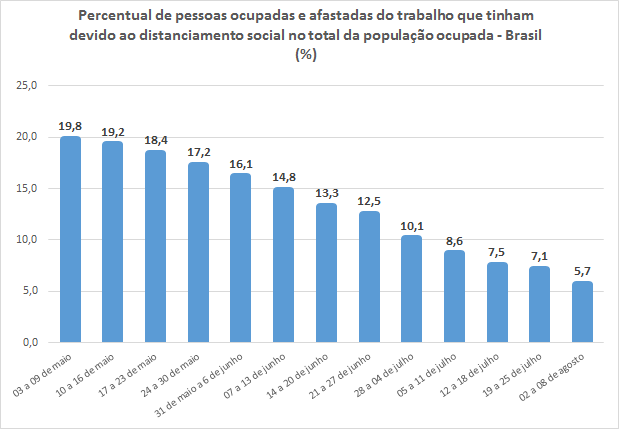PNAD COVID19: 5.7% of the employed population were away from work due to social distancing in the first week of August
August 28, 2020 09h00 AM | Last Updated: August 28, 2020 03h09 PM
That proportion fell against the previous week (7.1%) and the first week of the survey, from May 3 to 9 (1.8%).
According to PNAD COVID19, the employed population in the country between August 2 and 8 was 81.6 million, with stability against the preceding week (81.2 million persons) and a decrease in comparison with May 3 to 9 (83.9 million persons).
The employed population not away from work, estimated at 74.7 million persons, has increased since last week (72.3 million) and also against the May 3 to 9 (63,9 million). Among those persons, 8.6 million (or 11.5% of the employed population not away from work) were working remotely. That means stability against the preceding week (8.3 million or 11.5%) and, in absolute figures, in comparison with May 3 to 9 (8.6 million, but with a decrease in percentage against that week (13.4%).
The employment population ratio hit 47.9%, virtually unchanged against last week (47.7%) with a decrease against May 3 to 9 (49.4%).
The informality rate was 34.2% and remained stable against the preceding week (33.5%), but recorded a decrease versus May 3 to 9 (35.7%).
Approximately 4.7 million persons (or 5.7% of the employed population) were away from work due to social distancing. That figure decreased in both comparisons: against the preceding week (5.8 million or 7.1% of the employed population) and May 3 to 9 (16.6 million or 19.8% of the employed persons).


Fonte: IBGE, PNAD COVID19
The unemployed population (12.6 million persons) remained stable against the previous week (12.9 million), but above the result of May 3 to 9 (9.8 million). As a result, the unemployment rate was 13.3% for the period August 2 to 8, with stability against the preceding week (13.7%) and an increase versus the first week of May (10.5%).
The rate of participation in the workforce (55.3%) from August 2 to 8 remained stable in both comparisons: against the previous week (55.3%) and the first week of May (55.2%).
The population out of the workforce (who were neither working nor searching for work) amounted to 76.1 million, with stability against the preceding week (76.0 million) and the period of May 3 to 9 (76.2 million). From that total, 28.1 million persons (or 36.9% of the population out of the workforce) said they would like to work). That figure was stable in relation to the preceding week (28.0 million or 36.9%) and the first week of May, from 3 to 9 (27.1 million or 35.5%).
About 18.3 million persons out of the workforce (24.1%) who would like to work and did not search for work, did not due do it to the pandemic or for not finding a position in the locality where they lived. That figure remained stable against the preceding week (18.5 million or 24.4%) and against May 3 to 9 (19.1 million or 25.1%).
3.2 million persons with flu-like symptoms sought assistance at a health establishment
PNAD COVID19 estimated that, from August 2 to 8, 13.0 million persons (or 6.2% of the population in the country) reported at least one of the 12 flu-like symptoms investigated by the survey (fever, cough, sore throat, difficulty to breathe, headache, chest pain, nausea, runny or stuffy nose, fatigue, pain in the eyes, loss of taste or smell and muscular pain).That result was stable against that in the preceding week (13.3 million or 6.3% of the population) and fell in comparison with the figure for May 3 to 9 (26.8 million or 12.7%).
Approximately 3.2 million persons (or 24.3% of those reporting symptoms) sought assistance at a health establishment (community health units, family health staff, UPA, SUS Emergency Care Units of Hospital, or even private ambulatory/medical office care or hospital). The figure remained stable against that in the preceding week (3.3 million or 24.3%) being stable in absolute figures but recording increase in percentage terms) against May 3 to 9 (3.7 million or 13.7%). The public health system was responsible for 82% of the assistance provided in this case.
From August 2 to 8, 223 thousand persons (7.0%) reporting flu-like symptoms sought assistance at a private or military ambulatory care unit. There was stability against the preceding week (238 thousand or 7.3%) and decrease against the first week of May (320 thousand or 8.7%).
About 974 thousand persons sought assistance at a public, private or military hospital between August 2 and 8. That figure was statistically unchanged against the previous week (1.1 million) and against May 3 to 9 (1.1 million).
Among persons seeking assistance at a hospital, 136 thousand (14.0%) were hospitalized, a sign of stability against the preceding week (159 thousand or 14.5%) and against May 3 to 9 (97 thousand or 9.1%).

